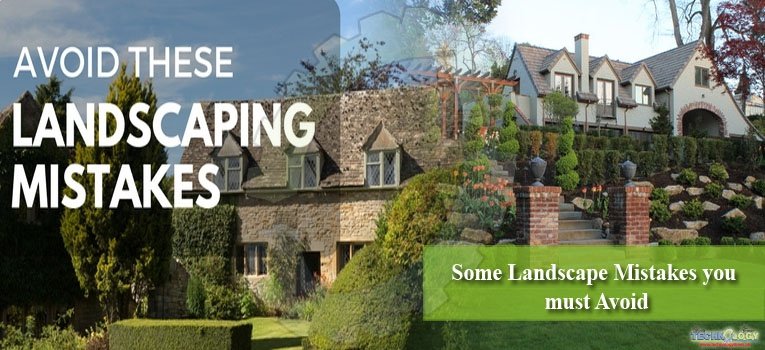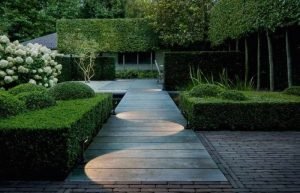Look around, and you’ll see some homes with attractive, well-kept yards, and other homes where the property owners have made some kind of mistakes.

But here’s the thing about landscaping errors: they can be avoided, or at the very least, fixed. Here are a few common mistakes to watch out for.
Valuing aesthetics over function
We all want a beautiful backyard, but it’s important not to lose sight of usefulness. Look for ways to blend aesthetics with function.
For example, planting evergreen trees gives your property color all year round, while also providing another layer of privacy. And installing a rock garden might look pretty, but it may not be the best choice for families with small children running around.
In the end, functionality should trump aesthetics in landscaping, but it’s possible to have both.
The common water feature
There was a time when a backyard pond was cutting edge. This eventually evolved into the story of the “stone necklace.” You may have seen these or may even have one. The stone necklace is the term given to the ever present rock-ringed garden pond. The stones are initially placed around the perimeter of the pond to conceal and / or anchor the flexible liner.
The result is a water feature with perhaps pleasant sound but appearing anything but natural. If you have one of these situations, consider installing a few crawling plants in a few key areas around the edge to help conceal some of this stone. Adding a bog (shallow, consistently wet planting area) to one end may also help mitigate some of the stone.
Failure to connect indoors with outdoors
If your outdoor landscape is successfully designed to become a visual extension of adjacent rooms, the whole will seem greater than the sum of its parts. This is doubly important in smaller homes where the patio or garden is vital to utilizing every square inch of what can be very expensive real estate. Beware of a design that fails to do this in every possible way.
This connection relies on carrying the colors, textures and style of your indoor spaces over the threshold to the outdoor materials choices. When the French doors or slider is closed, your eye should travel across the room and through the glass to the outdoors as seamlessly as possible.
When the doors are thrown open you want the transition point to literally disappear. Key to this is paving materials that are nearly identical, such as travertine flooring indoors and a matching ceramic tile or imprinted, colored concrete outside. Also key is to match the decorating style to furniture, plants, exterior partitions, and decor outside.

Over-sized Plants
Planting design is all about selecting the perfect plant for every space in the landscape. That plant should fit in the space provided when it reaches maturity, which is its maximum height and diameter. This is particularly important with shrubs used in foundation planting around the house.
When a plant selected grows too large for the space provided, particularly when it is in a crucial spot such as a tight entry or beneath a window, the gardener must prune it to size. This is most often done by shearing the plant into the space, which spoils its foliage, flowers, and sometimes attractive fruit.
When you see homes with a lot of shearing going on, it’s because the plants have outgrown their spaces. It also tells you there’s a lot of maintenance required to keep it looking good.
A good designer knows the dimensions and character of every plant he or she specifies for a project. This allows the plant to reach its ultimate size while retaining its natural beauty as envisioned on the drawing board. It does not become a box, ball or pyramid. The plant, like its siblings in the wild, grows to be relatively maintenance free, saving you labor, time and money.

Lack of lighting
When planning a landscape budget, lighting is rarely mentioned. This is unfortunate. So much time and money is invested in creating a beautiful outdoor environment, it’s unfortunate much of it isn’t seen after the sun sets. Outdoor lighting doesn’t need to be complicated or outlandish.
One saying in the outdoor lighting industry is “a little light goes a long way.” A 60- or 75-watt lamp is great to read by, but putting the same intensity outdoors can be overpowering. Low-voltage lighting uses a transformer to step down voltage from 120v to 12v, generally speaking. The lamps may range from 10 to 35 watts.

Forgetting the local wildlife
You’ve put a lot of time and money and sweat into planting flowers and vegetables in your yard. But as far as the local deer and rabbit populations are concerned, you’ve just invited them over for dinner.
But you can avoid turning your garden into a buffet for the animals by planting some bitter-tasting flowers such as foxglove, rosemary, mint or heather. Once deer get a taste of these plants, they’ll be less likely to return.
You can build a fence, or a put up some chicken wire, around your garden to keep away wild rabbits and other smaller creatures.
Forgetting about fall and winter
When it comes to planting and landscaping, it’s easy to spend most of your time focused on the warmer weather months.
But don’t forget about fall, and the rich colors that come with it, or about how much you’ll miss splashes of color during the grey winter months. Your planting agenda should include some things that will remain bright long after summer ends.
For example, winterberry or deciduous holly will display bright red berries in the dead of winter, while mums, sumac and pansies offer some delightful colors for fall.
Poor rock placement
Boulders in the garden can add an amazing, natural architectural dimension. Unfortunately, a very common problem occurs when these gifts from the earth are placed haphazardly on the landscape. You may have witnessed The Great Rock Drop. You have likely seen these abnormalities where accent boulders aren’t nestled into the beds, but just placed on them.
To be successful (look natural,) boulders should be planted. They should be buried up to the point of their widest measurement. Whenever you can see a boulder angle back towards its center, it’s pretty easy to estimate its total mass. Ideally, you’d like these features to replicate natural rock outcroppings where one passing by sees only the tip of the iceberg
Under-estimating importance of good design
A beautiful, well designed landscape costs the same as a poorly designed one. This difference is with the designer. Well trained landscape designers who work with a large palette of plants and materials as well as a wide range of styles are geared to give you a fine project. An installer who has little training may get the plan done, but it won’t be great and it will do even less for the beauty and enjoyment of your home.
Plan to spend a bit more time to find a reputable designer. Make calls and ask for references. Talk to former clients to verify all claims. Visit those jobs if you can. For just as an architect can design an ordinary tract house or a beautifully detailed cottage, a landscape designer can create a vital and lovely outdoor living space, or just a patio and some plants for about the same price.
Whether you need landscape maintenance, landscape lighting, irrigation or tree, shrub or plant care, we can make sure your landscape looks its best.